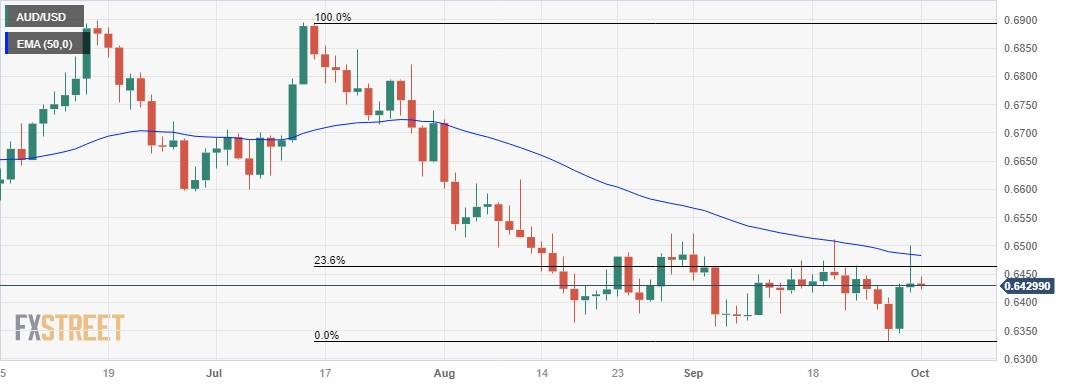- Australian Dollar retreats from recent gains ahead of the RBA interest rates decision on Tuesday.
- RBA is expected to keep current interest rates at 4.1%.
- Australia’s TD Securities Inflation grew 5.7% in September, lower than 6.1% in August.
- US passed bills to avert a government shutdown, securing funding until November 17.
The Australian Dollar (AUD) snaps the winning streak on the third successive day on Monday. The AUD/USD pair received upward support, primarily supported by the upbeat Chinese PMI data released over the weekend. However, the US Dollar (USD) continues to demonstrate resilience after the moderate economic data released on Friday.
Australia’s TD Securities Inflation (YoY) data showed that inflation estimation in September was lower than August’s readings. The Reserve Bank of Australia (RBA) is expected to keep the interest rate unchanged in the upcoming policy meeting on Tuesday.
However, the Consumer Price Index (CPI) in Australia for the month showed improvement compared to July, which could be attributed to the increasing energy prices. The rise in inflation could impact the RBA’s policy decision.
The US Dollar Index (DXY) holds ground to continue to gain in the second trading session after the moderate datasets from the United States (US). Core Personal Consumption Expenditures (PCE) - Price Index (YoY) for August rose as estimated but lowered than July’s figures.
US Core PCE (MoM) showed a soft reading against the market consensus. While the Michigan Consumer Sentiment Index (Sep) improved from the previous figures.
Additionally, the USD’s strength is attributed to the positive performance of US Treasury yields. The yield on the 10-year US Treasury note hovers below the record highs.
Daily Digest Market Movers: Australian Dollar weakens on market caution, RBA decision
- AUD/USD retraces the intraday losses, trading above 0.6400 at the time of writing during European trading hours on Monday.
- The Aussie Dollar could further face challenges due to increased market caution surrounding the US Federal Reserve (Fed) interest rates trajectory.
- AUD/USD weakens due to the likelihood of the RBA to keep current interest rates at 4.1% in the upcoming policy meeting on Tuesday.
- Australia’s TD Securities Inflation (YoY) rose 5.7% in September, lower than 6.1% in August.
- Australia’s Monthly Consumer Price Index (CPI) year-over-year for August rose 5.2% as expected, up from the previous rate of 4.9%.
- China’s Manufacturing PMI data rose into positive territory. China’s NBS Manufacturing PMI for August grew to 50.2 from the previous 49.7 figures, exceeding the 50.0 expected.
- Additionally, the Non-Manufacturing PMI rose to 51.7 from the 51.0 previous reading, surpassing the market consensus of 51.5.
- The upbeat US Treasury Yields are contributing support to the USD’s strength.
- US Core PCE - Price Index (YoY) for August rose 3.9% as estimated, eased from the previous reading of 4.3%. Core PCE (MoM) showed a soft reading of 0.1% against the market consensus to be consistent at 0.2%.
- US Michigan Consumer Sentiment Index (Sep) improved to 68.1 from the previous figure of 67.7, which was expected to remain unchanged.
- After the Friday session, bills were successfully passed in the US to avert a government shutdown, securing funding until November 17. This development has prompted a resumption of the US Dollar Index (USD) upward trajectory.
- Traders await US ISM Manufacturing PMI for September ahead of Fed Chair Jerome Powell's speech on Monday. The RBA interest rate decision will be eyed on Tuesday.
Technical Analysis: Australian Dollar hovers around 0.6400, support around September’s low
Australian Dollar trades lower around 0.6410, followed by the 0.6450 level. A firm break below the latter could open the doors for the AUD/USD pair to navigate the region around September’s low at 0.6331 aligned to the 0.6300 psychological level. On the upside, the 23.6% Fibonacci retracement at 0.6464 emerges as the key barrier, followed by the 50-day Exponential Moving Average (EMA) at 0.6482.
AUD/USD: Daily Chart
Australian Dollar FAQs
What key factors drive the Australian Dollar?
One of the most significant factors for the Australian Dollar (AUD) is the level of interest rates set by the Reserve Bank of Australia (RBA). Because Australia is a resource-rich country another key driver is the price of its biggest export, Iron Ore. The health of the Chinese economy, its largest trading partner, is a factor, as well as inflation in Australia, its growth rate and Trade Balance. Market sentiment – whether investors are taking on more risky assets (risk-on) or seeking safe-havens (risk-off) – is also a factor, with risk-on positive for AUD.
How do the decisions of the Reserve Bank of Australia impact the Australian Dollar?
The Reserve Bank of Australia (RBA) influences the Australian Dollar (AUD) by setting the level of interest rates that Australian banks can lend to each other. This influences the level of interest rates in the economy as a whole. The main goal of the RBA is to maintain a stable inflation rate of 2-3% by adjusting interest rates up or down. Relatively high interest rates compared to other major central banks support the AUD, and the opposite for relatively low. The RBA can also use quantitative easing and tightening to influence credit conditions, with the former AUD-negative and the latter AUD-positive.
How does the health of the Chinese Economy impact the Australian Dollar?
China is Australia’s largest trading partner so the health of the Chinese economy is a major influence on the value of the Australian Dollar (AUD). When the Chinese economy is doing well it purchases more raw materials, goods and services from Australia, lifting demand for the AUD, and pushing up its value. The opposite is the case when the Chinese economy is not growing as fast as expected. Positive or negative surprises in Chinese growth data, therefore, often have a direct impact on the Australian Dollar and its pairs.
How does the price of Iron Ore impact the Australian Dollar?
Iron Ore is Australia’s largest export, accounting for $118 billion a year according to data from 2021, with China as its primary destination. The price of Iron Ore, therefore, can be a driver of the Australian Dollar. Generally, if the price of Iron Ore rises, AUD also goes up, as aggregate demand for the currency increases. The opposite is the case if the price of Iron Ore falls. Higher Iron Ore prices also tend to result in a greater likelihood of a positive Trade Balance for Australia, which is also positive of the AUD.
How does the Trade Balance impact the Australian Dollar?
The Trade Balance, which is the difference between what a country earns from its exports versus what it pays for its imports, is another factor that can influence the value of the Australian Dollar. If Australia produces highly sought after exports, then its currency will gain in value purely from the surplus demand created from foreign buyers seeking to purchase its exports versus what it spends to purchase imports. Therefore, a positive net Trade Balance strengthens the AUD, with the opposite effect if the Trade Balance is negative.
Information on these pages contains forward-looking statements that involve risks and uncertainties. Markets and instruments profiled on this page are for informational purposes only and should not in any way come across as a recommendation to buy or sell in these assets. You should do your own thorough research before making any investment decisions. FXStreet does not in any way guarantee that this information is free from mistakes, errors, or material misstatements. It also does not guarantee that this information is of a timely nature. Investing in Open Markets involves a great deal of risk, including the loss of all or a portion of your investment, as well as emotional distress. All risks, losses and costs associated with investing, including total loss of principal, are your responsibility. The views and opinions expressed in this article are those of the authors and do not necessarily reflect the official policy or position of FXStreet nor its advertisers. The author will not be held responsible for information that is found at the end of links posted on this page.
If not otherwise explicitly mentioned in the body of the article, at the time of writing, the author has no position in any stock mentioned in this article and no business relationship with any company mentioned. The author has not received compensation for writing this article, other than from FXStreet.
FXStreet and the author do not provide personalized recommendations. The author makes no representations as to the accuracy, completeness, or suitability of this information. FXStreet and the author will not be liable for any errors, omissions or any losses, injuries or damages arising from this information and its display or use. Errors and omissions excepted.
The author and FXStreet are not registered investment advisors and nothing in this article is intended to be investment advice.
Recommended content
Editors’ Picks

EUR/USD recovers from two-year lows, stays below 1.0450
EUR/USD recovers modestly and trades above 1.0400 after setting a two-year low below 1.0350 following the disappointing PMI data from Germany and the Eurozone on Friday. Market focus shifts to November PMI data releases from the US.

GBP/USD falls to six-month lows below 1.2550, eyes on US PMI
GBP/USD extends its losses for the third successive session and trades at a fresh fix-month low below 1.2550 on Friday. Disappointing PMI data from the UK weigh on Pound Sterling as investors await US PMI data releases.

Gold price refreshes two-week high, looks to build on momentum beyond $2,700 mark
Gold price hits a fresh two-week top during the first half of the European session on Friday, with bulls now looking to build on the momentum further beyond the $2,700 mark. This marks the fifth successive day of a positive move and is fueled by the global flight to safety amid persistent geopolitical tensions stemming from the intensifying Russia-Ukraine war.

S&P Global PMIs set to signal US economy continued to expand in November
The S&P Global preliminary PMIs for November are likely to show little variation from the October final readings. Markets are undecided on whether the Federal Reserve will lower the policy rate again in December.

Eurozone PMI sounds the alarm about growth once more
The composite PMI dropped from 50 to 48.1, once more stressing growth concerns for the eurozone. Hard data has actually come in better than expected recently – so ahead of the December meeting, the ECB has to figure out whether this is the PMI crying wolf or whether it should take this signal seriously. We think it’s the latter.

Best Forex Brokers with Low Spreads
VERIFIED Low spreads are crucial for reducing trading costs. Explore top Forex brokers offering competitive spreads and high leverage. Compare options for EUR/USD, GBP/USD, USD/JPY, and Gold.
